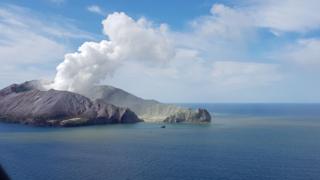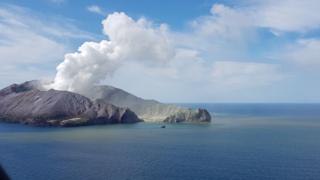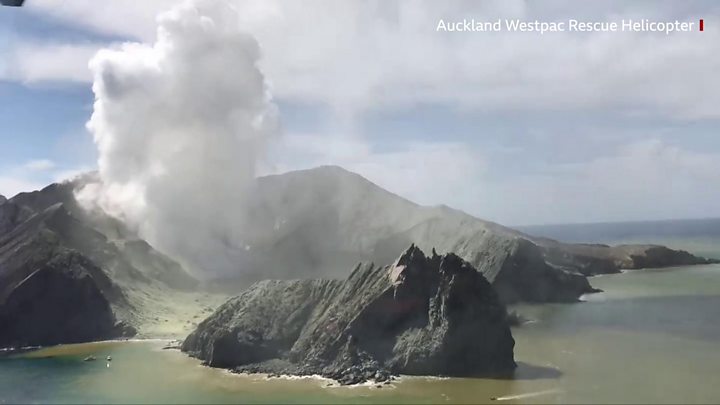White Island volcano: New volcanic activity hampers recovery efforts
Police says it’s too dangerous to retrieve the nine people presumed dead that are still on the island. …

 Image copyright AFP
Image copyright AFP New Zealand’s White Island volcano is showing increased seismic activity, putting recovery efforts on hold.
Authorities hoped they would be able to retrieve the nine people presumed dead on the island on Wednesday.
So far, six people have been confirmed dead in the tragedy. Another 29 are in intensive care with severe burns and one has been moved to Australia.
The volcano, also known as Whakaari, erupted on Monday when dozens of tourists were on the island.
“I’ve spoken to many of those involved in the operation and they are very, very eager to get back there, they want to bring people’s loved ones home,” Prime Minister Jacinda Ardern told reporters.
Meanwhile, the identification process and post mortem examinations of the victims are under way.
What state are the injured in?
White Island is a popular tourist destination with frequent day tours and scenic flights available. At least 47 visitors from around the world were on the volcano crater at the time of two explosions in quick succession.
Police said that of the 30 injured, 25 are in a critical condition while the other five are classed as stable but serious.
Mr Nash explained the injuries to the survivors were so severe that some of them were unable to identify themselves.
“There are a number of people in hospital who cannot communicate, they have significant burns not only to skin but internal organs,” he told Radio New Zealand.
“We wish them the best but we’re not out of the woods yet, of that there’s no doubt.”
Dr Peter Watson, chief medical officer at New Zealand’s National Burns Unit said an estimated 1.2 million sq cm of replacement skin will be needed for the patients. An order has been placed from the US.
Several patients will be transferred to Australia by the Australian Defence Force using an intensive-care acceptable aircraft in the next 24-48 hours, Dr Watson said.
Where does donor skin come from?
Analysis by James Gallagher, BBC health and science correspondent
Donated skin is vital for helping to save the life of a major burns patient. Skin is our largest organ and its main job is keeping dangerous viruses and bacteria out.
The damage caused by severe burns leaves patients at very high risk of infection. Donor skin is a short-term fix.
It comes from dead organ donors – in the same way as hearts, kidneys and corneas – and can be banked for several years.
The donor-skin aids healing, cuts the risk of infection and can reduce pain. The immune system is so weak after such an injury that rejection is not an issue.
A single major burns patient needs a lot of donor skin. New Zealand is treating 29 at the same time and has needed to turn to other countries for help.
What do we know about the victims?
New Zealand’s chief coroner on Wednesday declared the eruption a “mass fatality incident”.
Officials said they are working with disaster specialists and forensic experts to identify the victims so they can be returned to their families.
New Zealand police have now listed nine people as officially missing – though they say this is a partial list as they have not been able to speak to all the next of kin.
These are:
- Gavin Dallow (Australia)
- Jessica Richards (Australia)
- Krystal Browitt (Australia)
- Richard Elzer (Australia)
- Zoe Hosking (Australia)
- Karla Matthews (Australia)
- Julie Richards (Australia)
- Tipene Maangi (New Zealand)
- Hayden Inman (New Zealand)
At least five people on the list are believed to be dead or presumed dead based on relatives talking to media.
Tour guide Hayden Inman was identified as among the dead by his brother on Facebook.
Julie Richards and her daughter Jessica from Brisbane, Australia were identified as victims by a family spokesperson.
Adelaide father Gavin Dallow has been named as dead, with his stepdaughter Zoe Hosking presumed dead, according to media reports.
There is also a definitive list of all victims who are in hospital but police say they cannot release this for privacy reasons.

Media playback is unsupported on your device
Why is the recovery delayed?
On Wednesday morning, geological agency GeoNet said “the level of volcanic tremor has significantly increased at the island”.
Scientists view tremors, which result from a release of energy under the Earth’s surface, as one sign of a possible eruption.
In a later update, the agency said volcanic tremor, known as seismic activity, was now at the highest level seen since 2016.
“The level of volcanic tremor continues to rise and there is medium likelihood of future eruptive activity in the next 24 hours,” the agency said.
At a news conference on Wednesday, volcanologist Graham Leonard said seismic activity on White Island was escalating.
“Yesterday there was a high risk of an eruption,” Mr Leonard said. “Today there is an even higher risk of an eruption. And the parameters are worsening at the moment.”
Police said the latest seismology update meant recovery teams had no choice but to wait but were on constant standby to return to the island as soon as possible.
Police Minister Stuart Nash said there were also poisonous gases coming from the volcanic vent and that the island was blanketed in a thick layer of acidic ash.
With measuring equipment on the island still intact, GeoNet can give regular updates on the situation, allowing police to assess the risk of sending recovery teams.
Reconnaissance flights have shown no signs of life on the island and officials believe there are no survivors among the eight missing.
Police said a drone conducted four fly-overs of the island on Wednesday and analysis of that footage is ongoing.
Are you in the area? If it’s safe to share your experiences then please email haveyoursay@bbc.co.uk.
Please include a contact number if you are willing to speak to a BBC journalist. You can also contact us in the following ways:
- WhatsApp: +44 7756 165803
- Tweet: @BBC_HaveYourSay
- Send pictures/video to yourpics@bbc.co.uk
- Upload your pictures / video here
- Text an SMS or MMS to 61124 or +44 7624 800 100
- Please read our terms & conditions and privacy policy




